- 2016 National Plan annual review
In accordance with the National Plan, the National Plan Strategic Coordination Committee (NPSCC) is responsible to ensure that the national plan remains current and effective. On behalf of the NPSCC, AMSA is responsible for conducting an annual review of the National Plan by no later than 31 October each year, for the NPSCC’s consideration.
Accordingly, proposed amendments were sought from the various National Plan members as part of the 2016 review process; and presented to the NPSCC and National Plan Strategic Industry Advisory Forum (NPSIAF) for consideration at their respective November 2016 meetings. The majority of changes were editorial in nature and largely related to agency and terminology updates that have taken place since the National Plan’s annual review in 2015.
- Oil spill monitoring handbook
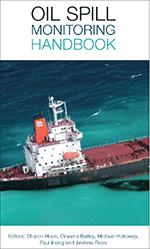
The 2003 edition Oil Spill Monitoring Handbook has been given a significant review and update by an expert team led by the CSIRO.
The handbook contains an overview of the chemical and physical properties of oil, the toxicological impacts of oil exposure, and the impacts of oil exposure on different marine habitats with relevance to Australia. It also provides guidance to oil spill monitoring by showing how it should integrate into response arrangements, and how it supports decision-making, such as net environmental benefits analysis. It contains significant general guidance on spill monitoring approaches and technologies and is supplemented by indepth discussion on both response phase and recovery phase monitoring design and delivery. Appendices describe detailed standard operating procedures for practical observation, and sample and data collection.
Copies of the handbook are available for purchase from the CSIRO website for A$89.95 and will be made available to download later in the year.
- National Plan year in review
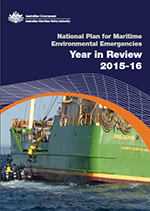
The 2015-16 National Plan year in review (annual report) is available on the AMSA website.
Contact us for a hardcopy of the review.
- AMSA salvage and intervention (S&I) activities
Protection and indemnity (P&I club) workshop

There are thirteen separate and independent principal clubs in the International group of P&I clubs and between them, provide liability cover (protection and indemnity) for approximately 90 per cent of the world's ocean-going tonnage.
Clubs cover a wide range of liabilities, including loss of life and personal injury to crew, passengers and others on board, cargo loss and damage, pollution by oil and other hazardous substances, wreck removal, collision and damage to property. Clubs also provide a wide range of services to their members on claims handling, legal issues and loss prevention; often playing a lead role in coordinating the response to, and management of, maritime casualties.
AMSA is in the process of planning a P&I club workshop which will be held in the second half of the year. Invitation for attendance will be circulated to the thirteen major P&I clubs and their local correspondent. The workshop will cover a range of case studies, communication protocols, parties’ priorities and expectations during a maritime casualty incident which requires joint cooperation from AMSA, P&I clubs and their correspondent.
Coral Knight towing exercise
AMSA is planning a towing exercise which is scheduled to take place in the first half of the year, in far North Queensland. The exercise will involve a large commercial vessel and will test the operational capability of the level 1 emergency towage service provided by the Coral Knight.
An overview of the exercise will be provided in the September edition of On Scene.
- Incident snapshot
MT Bow Singapore
On 19 August 2016 at approximately 1611hrs local time the MT Bow Singapore was inbound to Geelong approaching the Eastern end of the South channel with a cargo of sulphuric acid when the vessel suffered steering gear failure and grounded at a speed of 3 knots.
AMSA was notified via the AMSA Response Centre; who then notified the AMSA Salvage and Intervention, Marine Environment Protection Response and Ship Safety Duty Officers and the Port of Melbourne Harbourmaster. At the time of the grounding, the vessel was under pilotage and due to a falling tide, was unable to be immediately re-floated. The owners engaged Ardent Salvage to assist in the refloating attempt which was to use the tug Hastings from Geelong with a Salvage Master onboard.
The vessel was successfully refloated at 0110hrs on 20 August 2016 and with the assistance of the tug went to anchor off Melbourne where divers, relevant classification society and AMSA Port Surveyors undertook various inspections. No hull breach or pollution was identified.

MV Admiralty Spirit
At approximately 1300hrs on 11 November 2016, the MV Admiralty Spirit on passage from Malaysia to New Zealand exited the designated shipping route near Stagg Patches south of Cairns. The vessel’s Officer of the watch (the Second officer) changed course to account for the local tidal and current conditions however, failed to make further alterations to course to compensate for the conditions. A major incident was averted by the prompt action of the Great Barrier Reef and Torres Strait Vessel Tracking Service (ReefVTS) who alerted the vessel that it was exiting the designated shipping area. Once notified, the vessel’s course was altered and returned to the appropriate two-way route.
After having being notified by REEFVTS of the incident, AMSA contacted the vessel, the vessel’s coastal pilot and the flag state to establish the cause of the incident. It was reported that the Officer of the watch had made a navigational error consistent with the scenario previously described. The flag state confirmed their intentions to investigate the matter further. Following the near miss, AMSA monitored the vessel’s passage until she cleared the ReefVTS monitored area.

MV Norwegian Star
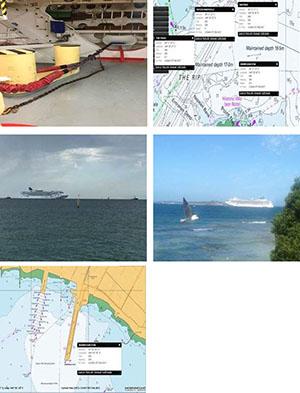
At 0413hrs on 10 February 2017, AMSA’s Salvage and intervention duty officer was notified that the MV Norwegian Star had suffered a complete propulsion failure and was drifting north easterly at 1.6 knots, 18 nautical miles south west of Cape Liptrap in calm weather and sea conditions. The vessel was carrying 1017 crew and 2113 passengers.
Discussions between the Master, the vessel owner (Norwegian Cruise Line Holdings) and AMSA indicated that the vessel had been operating on a single Azipod (propulsion unit) since 24 January 2017, when one unit had become unserviceable and was unable to be repaired. The second Azipod unit later failed at 0200hrs and it was determined highly unlikely it could be repaired.
Despite losing propulsion there was no interruption to essential and hospitality services, power supply, anchors’ and bow thrusters’ on board the vessel. It was agreed that if the vessel got within 45-50 metre depth of water, anchoring was to be attempted. However, given the underwater topography of the region, this would only be possible within 3 nautical miles of the coastline.
The ship’s owner reacted by engaging salvors (Ardent Global’s Australian operations) who coordinated commercial towage assets from Svitzer Australia’s Geelong and Melbourne operations deploying the tug Hastings and subsequently the Tom Tough and the Marysville.
The tug Hastings, with Salvage Master and Engineer aboard, secured a tow line to the MV Norwegian Star at 2046hrs on 10 February, and commenced towing the vessel back to Port Phillip Bay. During the night the tug Tom Tough rendezvoused with the vessels and assisted with escorting. At 1530hrs on 11 February a third tug, Marysville, arrived along with marine pilots who assisted the vessel’s transit to safety at Port Philip Bay.
Throughout the incident, AMSA assumed a coordination role and liaised with all parties (ship’s master, owner, agent, salvors, Port Phillip and Western Port Harbour Masters, Victorian maritime, emergency and safety authorities). Once the vessel was secured safely alongside, AMSA’s Operations team undertook relevant port State control measures.
- Maritime casualty officers (MCO) workshop and training
AMSA hosted an MCO workshop and a series of training from 28 February to 6 March 2017. Participants of the workshop were a select group of AMSA Port marine surveyors who have additional responsibilities as Maritime casualty officers (MCOs). The role of an MCO is to be deployed to a vessel that is in need of assistance, also known as a mritime casualty. The MCO is required to serve as a liaison between the master and crew of the casualty and the Maritime emergency response commander (MERCOM).
The purpose of the workshop and training is to ensure MCOs are familiar with their roles, responsibilities and the risks involved in deployment to a marine casualty. The workshop and training provided the opportunity to ensure MCOs are adequately trained, are familiar with safety and operational procedures and the equipment required when deployed to a maritime casualty. This training included helicopter under water escape training and emergency breathing systems. Additionally, aspects related to safe work around aircraft training including hover entry and exit, static, overland and water winching from a vessel were exercised.

- National casualty management guidance document
During AMSA’s review of its internal casualty management guidelines it was found that the document mainly described AMSA internal processes, with very limited information regarding jurisdictional management of casualties. AMSA believes there may be benefit in developing a National casualty management guidance document for broad national application.
Further, that such a document could establish an agreed national framework for states, Northern Territory and AMSA to utilise, in a similar fashion to the place of refuge risk assessment guidance.
In November 2016 the National Plan Strategic Coordination Committee (NPSCC) agreed to AMSA’s proposal for the development of a National maritime management guidance document. A working group was established and it is expected that the guidance document will be finalised in the second half of the year.
- Australia—Papua New Guinea Torres Strait Treaty cycle meetings
The Australian Government hosted this years Torres Strait Treaty Cycle Meetings on Thursday Island, on 1 December 2016.
The Torres Strait Treaty entered into force in February 1985 and defines the border between Australia and Papua New Guinea (PNG), providing a framework for the management of the common border area. As well as defining maritime boundaries between PNG and Australia, the treaty protects the way of life traditional inhabitants in the Torres Strait protected zone (TSPZ). The treaty is recognised as one of the most creative solutions in international law to a boundary issue touching on the lives of traditional inhabitants. A special provision of the treaty allows free movement (without passports or visas) between Australia and PNG for traditional activities. This is only for Torres Strait Islanders and coastal people from PNG who live in and keep the traditions of the region.
The meetings provide a forum for traditional inhabitants of both countries, and respective government agencies, to discuss issues and activity in the region, and report concerns or make recommendations to the foreign ministers of Australia and PNG. Discussions centre on immigration and free movement; health; cross-border customs, law enforcements and biosecurity issues; environmental management; fisheries and maritime safety.
It is estimated that there are between 2000 and 10,000 small craft vessel movements from the PNG treaty villages to Australian Torres Strait communities each year. As such, AMSA works very closely with the PNG National Maritime Safety Authority (NMSA) in various capacities, including with their small craft team. PNG-NMSA are also a program partner of the Torres Strait marine safety program (TSMSP). Shaun Skerritt, AMSA’s advisor for the Torres Strait program, said that the PNG treaty villages have very limited financial means to access safety equipment when undertaking voyages within the TSPZ. AMSA, on behalf of the TSMSP, has provided lifejackets to all of the PNG treaty villages so that some lifesaving equipment is available and we continue to work with our PNG counterparts to improve maritime safety within the region. During the recent meetings, AMSA facilitated discussions between the PNG-NMSA small craft team and Queensland Police Service representatives to review marine safety initiatives; search and rescue; compliance and enforcement.
- National Plan decontamination strategy
AMSA, in collaboration with ACT Fire and Rescue, will be developing a decontamination strategy and capability for oil spill response. ACT Fire and Rescue has the technical and network expertise which will allow AMSA to provide an operational decontamination capability in support of the national plan. At the completion of this activity, AMSA will have a comprehensive National Plan for Maritime Environmental Emergencies Decontamination Strategy along with the appropriate document to allow AMSA to purchase any capabilities required.
- National response team workshop
The 2017 National response team (functional) workshop will be held in Canberra from 28 to 30 March 2017. This year’s workshop will build on previous workshops to cover a range of topics including human factors, team resource management, strategic decision making in uncertain situations and evaluation of incidents. The workshop will be facilitated by Ben Brooks, Senior research fellow in human factors and emergency management, at the National Centre for Ports and Shipping (Australian Maritime College). The workshop will also include a half-day session on incident evaluation.
- What’s happening at AMOSC?
Oil spill response training 2017
In 2017 AMOSC is again offering their full suite of oil spill training programs accredited to the International Maritime Organisation (IMO) Levels I, II and III in locations in Geelong and Perth. The Nautical Institute (UK) is the accrediting authority for the AMOSC courses and provides international oversight of the oil pollution preparedness, response and cooperation (OPRC) 90 derived marine oil spill response courses. In addition, AMOSC continue to offer specialist courses in shoreline, onshore-nearshore and aerial observation and also provide tailored training options to member companies to improve the effectiveness and efficiency of response operations, personnel and oil pollution emergency plans.
View the AMOSC website or connect with AMOSC on Linkedin
The course programme is as follows:
Course Name Dates Location Course in oil spill response management 1–4 May Geelong Course in oil spill response command and control 1–4 May Geelong Aerial observation 9–10 May Perth Course in oil spill response management 22–25 May Perth Course in oil spill response command and control 22–25 May Perth Revalidation course in oil spill response management 14–15 Jun Perth Revalidation course in oil spill response command and control 14–15 Jun Perth Course in oil spill response operations 10–14 Jul Perth Course in oil spill response management 24–27 Jul Geelong Course in oil spill response command and control 24–27 Jul Geelong Core group workshop – operations 7–10 Aug Perth Revalidation course in oil spill response management 21–22 Aug Geelong Revalidation course in oil spill response command and control 21–22 Aug Geelong Course in oil spill response management 4–7 Sep Perth Course in oil spill response command and control 4–7 Sep Perth Offshore–nearshore operations 2–4 Oct Perth Course in oil spill response management 9–12 Oct Geelong Course in oil spill response command and control 9–12 Oct Geelong Course in oil spill response operations 23–27 Oct Geelong Core group workshop – management and operations 13–16 Nov Geelong
- International oil spill conference (IOSC)
AMOSC has two oil spill preparedness abstracts accepted for the 2017 International oil spill conference in Long Beach, California, USA in May this year. AMOSC is looking forward to sharing their new developments, experiences and learnings amongst the international oil spill response community. AMOSC will be presenting and contributing a paper on Exercise Westwind – A Collaborative Oil Spill Response and a poster on Global Dispersant Stockpile Preparedness. In relation to the latter, AMOSC has deployed its dispersant testing programme across all of its stockpiles and is now regularly testing its dispersant batches to the ExDet dispersant testing protocol. This will give members and national plan partners assurance around the efficacy of AMOSC dispersant stocks.
Response
AMOSC has attended two spills this year; a level one heavy–fuel oil spill in a major port, as well as a report of sheen around a production platform. Both responses involved two AMOSC staff members attending the site of the spills to provide technical advice on shoreline clean up, monitoring and surveillance, and on water response options.
Exercises
AMOSC has a number of exercises planned for 2017. This includes providing support to its members involved in the Western Australia state exercise scheduled for quarter three and the development, delivery and assessment of a level three functional desktop exercise in quarter two. Additionally, AMOSC will be regularly testing its external service providers and internal preparedness through a series of hypothetical responses planned throughout the year.
- What’s happening in Victoria?
New state plan
Victoria has a new plan for maritime emergencies – the Maritime Emergencies (non-Search and Rescue (NSR)) Plan (Part A). This document outlines the governance, command, control, coordination, and preparedness arrangements for maritime emergencies including marine oil spills, hazardous and noxious substances, vessel casualties and wildlife impacted by marine pollution. Part B of the plan, which is currently being finalised, describes the operational arrangements for prevention, response and recovery from maritime emergencies. The Maritime Emergencies (NSR) Plan Part A is available online.
Exercises

Victoria has run two exercises in the past six months, a field deployment exercise in Portland and an Incident Management Team desktop exercise in Hastings.
In December 2016, the Port of Portland ran a first strike field deployment exercise. The 16 participants included staff from Port of Portland, Glenelg Shire Council, the Oil Response Company Australia and the Department of Economic Development Jobs Transport and Resources (DEDJTR). Staff deployed booms to protect an identified sensitive area within port waters from a hypothetical oil spill scenario. Objectives of the exercise included a review of occupational health and safety considerations; timeliness of response; and appropriate choice of equipment used for response. Participants used the opportunity to practice using locally available oil spill clean-up equipment.
Hastings
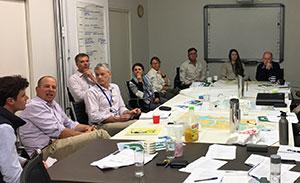
In November 2016, 16 organisations across government and industry, led by DEDJTR and port operator LINX, undertook a discussion exercise. The exercise was based on a rapidly unfolding hypothetical scenario in Western Port where a submarine became detached from its moorings and collided with a vessel containing heavy fuel oil. The exercise objectives were to examine control arrangements, support agency roles, handling of media and options for dealing with the specific scenario.
Upcoming exercises
Upcoming field deployment exercises will be held by Victorian Ports Corporation in collaboration with the new private port operators and Gippsland Ports as part of Victoria’s ongoing exercise program. DEDJTR will also be coordinating a state level exercise to test the new Maritime Emergencies (NSR) Plan. This exercise will be a desktop exercise focusing on coordination of a maritime emergency, requiring high level state involvement.
Training and exercising
Victoria has continued to maintain and enhance its marine pollution response capability over the past year by participating in two exercises and three training courses as outlined below. Two equipment operator courses and 23 shoreline courses will be conducted between March and June 2017. All Victorian trained responders and equipment will be loaded and maintained in AMSA’s National environmental maritime operations (NEMO) system.
Course Type Courses Participants Portland exercise 1 16 Hastings exercise 1 21 Incident controller course 1 2 Planning course 1 1 Incident management team 1 4 Total 5 44 New equipment purchases
Victoria is continuing to update its marine pollution equipment stockpile. Last year saw the acquisition of shoreline (land-sea based), curtain (self inflating and general purpose inflatable), and fence boom, significantly increasing Victoria's containment equipment stockpile. Procurement is currently underway for vessels (punts), containment and recovery systems (multi head skimming systems, vacuum systems), shoreline clean up and decontamination kits and recovered oil storage tanks (shoreline and on water systems). Our two large vessels will also undergo refurbishment to meet survey and safety requirements. It is anticipated that all procurement and refurbishment will be completed and goods delivered to Victoria’s stockpiles by the end of June 2017.
Rollout of NEMO system
Victoria is currently rolling out the NEMO system. Initially, the system will be used to streamline day to day tasks such as marine pollution incident notification and reporting, as well as management of the state’s marine pollution equipment assets. Later stages of the rollout will include collaborating with AMSA and other jurisdictions to develop the system for managing larger, protracted incidents. Stakeholder engagement in the development and the rollout of the system has been positive.
Staff movements
- DEDJTR farewelled Tim Wiebusch in October 2016, who for ten months filled the role of Director, Preparedness and recovery in the emergency management division (DEDJTR) and State controller, Maritime emergencies. Tim has moved on to a new position with Emergency Management Victoria.
- Russell McMurray has been appointed as Director, Capability and response, and assumed the mantle of State controller maritime emergencies (non-search and rescue). Russell brings a wealth of experience in emergency management from previous roles in biosecurity.
- DEDJTR have engaged two short-term assignments: Joe Kirby as Senior procurement officer until the end of February 2017 to procure the next cache of specialist equipment for the Marine pollution equipment project; and Sheeba Singh as Project manager (until the end of June 2017) to build and roll out the Victorian component of NEMO and Victoria’s new online mapping software.
- Rebecca Harper departed the Capability support officer role in September 2016 and has been replaced by Jiri Rutner (until May 2017).
- DEDJTR also bid farewell to Luke Dickens Project officer, after almost four years with the team. Luke contributed greatly to the state’s pollution response capability through his work on the equipment stockpile and other areas. Luke has commenced with Transport Safety Victoria as a Maritime safety officer. Recruitment for a new Project officer has commenced.
- What’s happening in New South Wales?
NSW training and exercises (Since last On Scene newsletter):
Activity Date Location Numbers Shoreline response course 11–13 October 2016 Magenta Shores, NSW 20 AMSA incident controllers (IC) course 17–21 October 2016 Victoria 2 Introduction to marine incident management (IMIM) course 2–3 November 2016 Sydney, NSW 30 Lord Howe Island exercise 21 November 2016 Lord Howe, NSW 17 Equipment deployment exercise 7 December 2016 Port Macquarie, NSW 19 Introduction to marine incident management (IMIM) course 1–2 February 2017 Sydney, NSW 24 Cost recovery workshop 9 February 2017 Sydney, NSW 10 Helicopter underwater escape training (HUET) 14 February 2017 Sydney, NSW 10 Total 117 Training and exercises planned (between March – September 2017):
Activity Date Location Cost recovery exercise 2 March 2017 Sydney, NSW Wildlife responders course 7–9 March 2017 Cronulla, NSW AMSA incident management team (IMT) course 20–24 March 2017 Victoria Equipment deployment exercise 30 March 2017 Moama, NSW National response team (NRT) workshop 28–30 March 2017 Canberra, ACT NSW incident controllers course 3–7 April 2017 Blacktown, NSW Chemical spill awareness course 1–3 May 2017 Port Kembla Incident action planning workshops 9–10 May 2017 Sydney, NSW Media officers workshop 15 May 2017 Sydney, NSW Aerial observation refresher course 16–17 May 2017 Murwillumbah, NSW Shoreline response course 23–25 May 2017 Kiama, NSW Advanced equipment operators course 29 May–2 June 2017 Sydney, NSW Introduction to marine incident management (IMIM) course 7–8 June 2017 Sydney, NSW AMSA incident management team (IMT) course 19–23 June 2017 Victoria, NSW Wildlife coordinators course 27–29 June 2017 Cronulla, NSW AMSA operations course 17–21 July 2017 Victoria, NSW State exercise 25–26 July 2017 Narooma, NSW NSW incident management team (IMT) course 31 July–4 August 2017 Katoomba, NSW Wildlife exercise – oily osprey 15-16 August 2017 Sydney, NSW AMSA incident management team (IMT) course 21–25 August 2017 Victoria Basic equipment operators course 21–25 August 2017 Port Kembla, NSW Lord Howe Island exercise 11 September 2017 Lord Howe Island South Coast RMS exercise 13 September 2017 Ulladulla, NSW AMSA planning course 18–22 September 2017 Victoria Chemical spill awareness course 19–21 September 2017 Newcastle, NSW
- What’s happening in Queensland?
Incidents
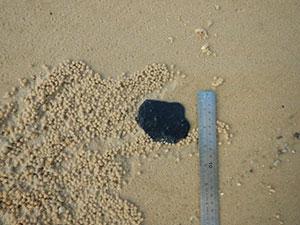
Queensland has received the usual reports of large oil slicks in offshore waters throughout the summer season. Fortunately these reports have turned out to be trichodesmium, also called sea sawdust or algal bloom, which is common in Queensland waters at this time of year. There have been a number of smaller spills of diesel fuel and bilge waste in boat harbours and marinas. However, one incident in particular stands out. It was a slick of weathered patties of heavy oil that impacted the eastern beaches of the world heritage listed Fraser Island on 17 October 2016. The incident involved the cleanup of approximately 60 kilometres of beach, which took eight days. The incident was managed by Maritime Safety Queensland (MSQ) with assistance from the Department of National Parks Sport and Racing, Department of Environment and Heritage Protection and the Fraser Coast Regional Council. While MSQ has been reasonably successful in identifying the likely source of oil spills in recent years, the weathered nature of the oil on this occasion means that the source of the pollution will remain a mystery.
Response arrangements
Aside from making the transition to AIIMS 4, Queensland’s oil spill response arrangements and key response personnel generally remain unchanged. MSQ continues to build on existing partnerships with port operators and other government and industry based organisations to enhance Queensland's response capability.
Work has commenced to redraft Queensland’s marine pollution legislation: the Transport Operations (Marine Pollution) Regulation 2008. The review will ensure our legislation remains current and incorporates the relevant aspects of MARPOL.
Training
MSQ continues to coordinate the delivery of basic and advanced equipment operator and shoreline response courses and to take advantage of the valuable incident management training activities provided by AMSA. Training activity in Queensland has continued with 78 personnel completing courses since September 2016.
Course Type Courses Participants Equipment familiarisation course 2 29 Incident controller course 1 1 Planning officer course 1 5 Shoreline response course 1 21 Finance and administration course 2 22 Total 7 78 Exercises
A major oil spill response exercise, Exercise pallarenda, was held in Townsville on 29 November 2016. The exercise scenario was based on a spill of 30 tonnes of intermediate fuel oil (IFO) 180 within the Port of Townsville. As the exercise scenario unfolded nearby beaches, rocky headlands and mangroves were impacted along with a variety of seabirds. The aim of the exercise was to test the multi-agency response to a significant ship-sourced oil spill within the port of Townsville. One of the exercise objectives was to test the Esri Collector App (for smartphones and tablets). Maritime Safety Queensland has configured the collector app to capture and share real time shoreline assessment and response data including images.
Other exercise objectives were to test the AIIMS 4 incident management structure, to test Queensland's oiled wildlife response capability and deploy oil spill response equipment including boom, skimmers and the national plan oiled wildlife cleaning equipment and container.
In total 57 people from ten different organisations participated in the exercise. Hallmarks of the exercise included great team work, good communication, full integration of the AIIMS-4 system and the early development of incident action plans and sub-plans. The practical deployment of the oiled wildlife response container and personnel enabled procedures to be tested and issues resolved. The value of increased situational awareness through the provision of real time reports and mapping via the ESRI Collector App was also evident.

- 2017 Australian search and rescue award
Nominations are now open for the 2017 Australian Search and Rescue Award.
The Australian National Search and Rescue (NATSAR) Council presents this award annually to recognise outstanding search and rescue efforts in Australia. The successful nominee(s) will have made a significant contribution to Australia’s search and rescue capability or to the saving of human life.
The award is open to any individual, group or organisation and may relate to a particular event or a sustained contribution over a period of time.
How to nominate:
- Download the Australian SAR award nomination form (available from the National Search and Rescue Council website)
- Complete the nomination form and return to the NATSAR Council (details are on the form) along with any supporting documentation.
Nominations are for the period July 2016 – June 2017 and close on Friday, 1 September 2017.
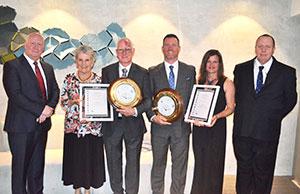
- National Plan training
Annual calendar
Courses available in 2017
May 8–12 Logistics officer Victoria 23–25 Shoreline response course New South Wales 29 May–2 June Advanced equipment operator New South Wales June 13–15 WA SRC Port Hedland 19–23 Incident management team Victoria July 17–21 Operations officer Victoria 25–26 Basic equipment operator WA DoT Dampier 31 July–4 August Incident management team New South Wales August 21–25 Incident management team Victoria 29–31 WA SRC Fremantle September 18–22 Planning officer Victoria October 16–20 Incident controller level 2 Victoria November 31 October–2 November WA SRC Geraldton For further information please contact us.